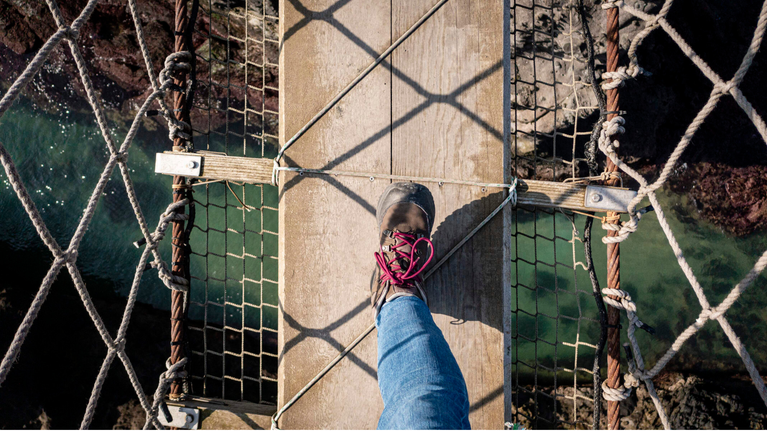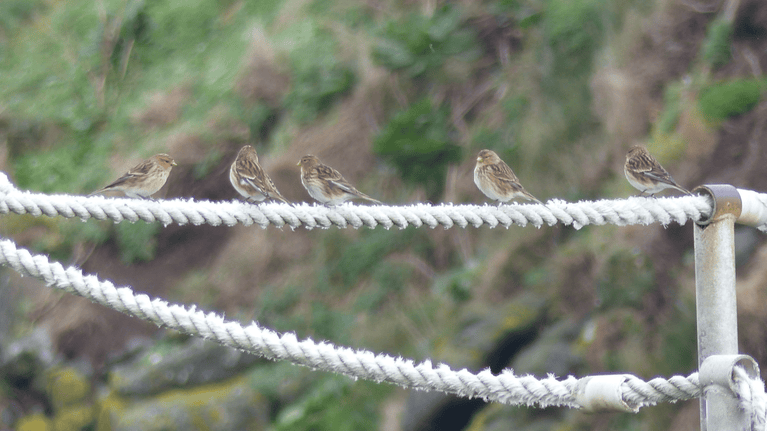
Discover more at Carrick-a-Rede
Find out when Carrick-a-Rede is open, how to get here, the things to see and do and more.

Take on the challenge of the famous Carrick-a-Rede Rope Bridge this autumn. Enjoy stunning views of the Scottish islands, spot soaring seabirds and basking sharks, and walk in the footsteps of salmon fishermen as you make your way from the mainland to Carrick-a-Rede island.
Suspended almost 30m (100ft) above sea level, Carrick-a-Rede rope bridge was first erected by salmon fishermen over 200 years ago.
Crossing the bridge is a thrilling experience and brave explorers are rewarded with stunning views across to Rathlin and the Scottish Islands, and a chance to see the original fishery on the island.
It is now a popular tourist attraction, which can frequently sell out of Visitor Experience tickets. For the best rates, pre-book your Visitor Experience tickets in advance. Pre-booking also helps us to prepare for your arrival and helps to spread visitor numbers more evenly throughout the day, improving everyone's experience. National Trust Members gain free access, however pre-booking is essential for everyone.
Whilst exploring Carrick-a-Rede, keep your eyes peeled for these 6 not-to-be-missed highlights.
Discover the industrial and maritime history held within the limestone walls of Larrybane Quarry as you trace the line of coast over windswept grasslands and winding rocky paths to Carrick-a-Rede Rope Bridge.
This 1km guided walk evokes memories of the past when the salmon fishery was at an all-time high and how fishermen first constructed a single handrail rope bridge to transport boxes of salmon caught off the island.
Stop with a member of the team at the white stones area for a short 15-minute chat to discover the rich history of this special place.
As the days grow shorter and the air turns crisp, Carrick-a-Rede takes on a quieter, more contemplative beauty. Whilst many insects retreat for the winter, autumn brings a different kind of wildlife spectacle to the site.
Dolphins remain a highlught all-year round, often seen leaping playfully through the waves. Their acrobatic displays delight visitors who are lucky enough to catch a glimpse from the rope bridge.
October marks the arrival of winter migrants, with family groups of whooper swans, having travelled all the way from Greenland, begin to pass overhead. These elegant birds are joined by other seasonal visitors, adding movement and sound to the skies above.
Along the wildflower-rich edges of the coast, flocks of linnets and goldfinches gather to feast on seeds. Occasionally, they're joined by their rare cousins, the twite - a treat for keen birdwatchers. These flocks are sometimes boosted by migrants, creating a lively mosiac of colour and song.
Also, keep your eyes peeled for our friendly robins and our furry stoats!

Share your Carrick-a-Rede memories with us! We'd love to see pictures of your visit to Carrick-a-Rede. When posting on social media, tag us for the chance to feature on our page!
Manual wheelchair available for loan
A manual wheelchair is available for loan from within the Tearoom. This is available on a first-come, first-served basis and can't be pre-booked. The first 0.5km of the coastal path is accessible, with an accessible telescope. After this viewing point, on route to the rope bridge, there are steeper slopes and two long sets of steps.
For more information, click here to view our full accessibility guide.
Sensory bags available for loan
At Carrick-a-Rede, we understand that the summer holidays can be a busy, overwhelming time for many and we want everyone to feel welcome and equal, whilst embracing the beauty of nature.
We're proud to offer sensory bags, which contain a selection of items designed specifically for visitors with sensory needs, including ear defenders, an emotion fan, various fidget items and a cuddly toy. These are available to loan from the Booking Hut, located in the main visitor car park.

Find out when Carrick-a-Rede is open, how to get here, the things to see and do and more.
The famous Carrick-a-Rede rope bridge was first erected by salmon fishermen in 1755. The name, from the Gaelic 'Carraig-a-Rade', means ‘The Rock in the Road’, an obstacle for the migrating salmon as they search for the river in which they were born. Follow in the footsteps of the vanishing fishermen by uncovering the history of Carrick-a-Rede.
